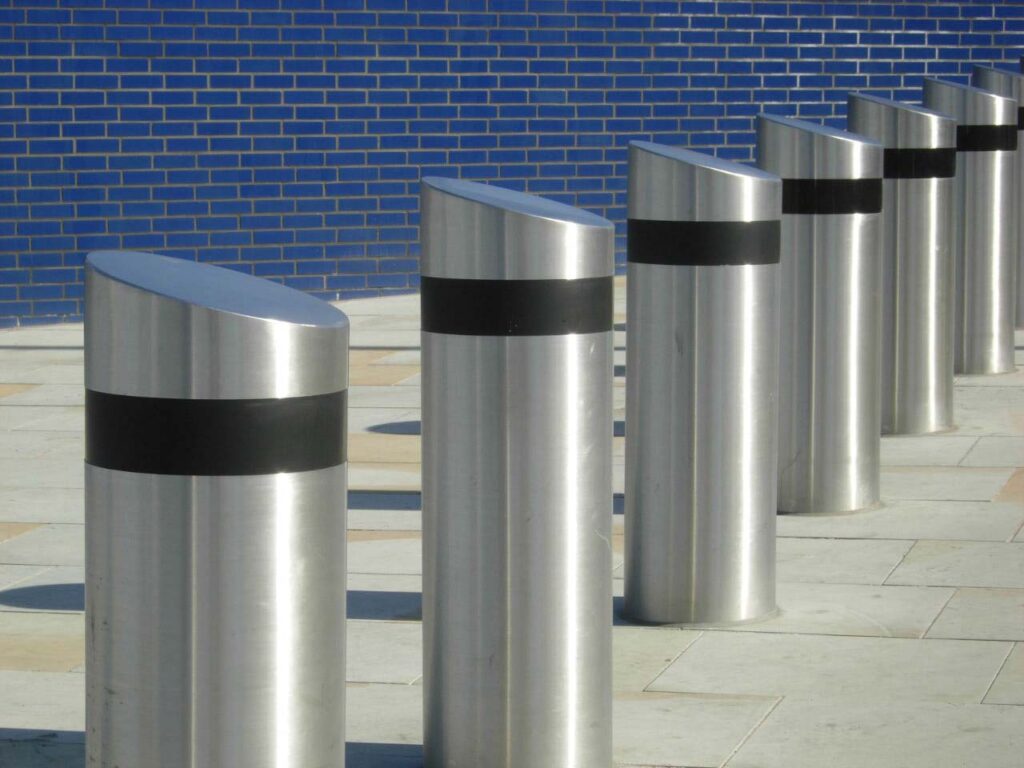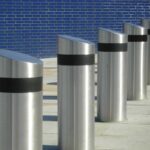Bollards are short, vertical posts installed to control or direct road traffic, enhance security, or provide architectural delineation. They are commonly used in urban environments, parking areas, and around buildings to prevent vehicle intrusion, guide pedestrians, and protect property. Here’s an in-depth look at what bollards are and the different types available.
What is a Bollard?
A bollard is a sturdy, vertical post designed to provide physical and visual barriers. Bollards can be made from various materials such as steel, concrete, plastic, or wood, and they come in different designs and sizes to suit specific applications. They are used for a variety of purposes, including:
- Traffic Control: To direct traffic flow and prevent unauthorized vehicle access.
- Security: To protect buildings and pedestrians from vehicle collisions or attacks.
- Aesthetic Purposes: To enhance the visual appeal of public spaces and architecture.
- Safety: To provide a safe pathway for pedestrians and cyclists by separating them from vehicular traffic.
Different Types of Bollards
Bollards come in several types, each designed for specific applications and environments. Here are the main types of bollards:
1. Fixed Bollards
Description: Fixed bollards are permanently installed in the ground and cannot be moved or adjusted.
Best For: Areas requiring constant and durable barriers.
Advantages:
- High Durability: Made from robust materials like steel or concrete for maximum strength.
- Security: Provides a reliable physical barrier to prevent vehicle access.
- Low Maintenance: Requires minimal upkeep once installed.
Applications: Building perimeters, pedestrian zones, and parking lots.
2. Removable Bollards
Description: Removable bollards can be temporarily removed or relocated as needed, offering flexibility in access control.
Best For: Areas where occasional vehicle access is required.
Advantages:
- Flexibility: Easily removed and reinstalled when needed.
- Versatility: Suitable for both temporary and permanent applications.
- Security: Still provides strong physical barriers when in place.
Applications: Event spaces, emergency access routes, and restricted parking areas.
3. Retractable Bollards
Description: Retractable bollards can be lowered into the ground when access is needed and raised to block access when necessary.
Best For: Locations needing controlled access that can be adjusted frequently.
Advantages:
- Convenience: Easily controlled, often with electronic or hydraulic mechanisms.
- Aesthetic Appeal: Retracts into the ground, maintaining a clean and unobtrusive appearance when not in use.
- Security: Provides a strong barrier when raised.
Applications: Driveways, government buildings, and commercial entrances.
4. Automatic Bollards
Description: Automatic bollards operate electronically, typically through remote control or automated systems, allowing for easy and rapid deployment.
Best For: High-security areas requiring quick and efficient access control.
Advantages:
- Automation: Operates automatically, offering high convenience.
- High Security: Provides robust protection against unauthorized vehicle access.
- Efficient Traffic Control: Can be synchronized with traffic management systems.
Applications: Military bases, airports, and high-security facilities.
5. Decorative Bollards
Description: Decorative bollards combine functionality with aesthetic design, enhancing the visual appeal of the surroundings.
Best For: Areas where visual appeal is as important as functionality.
Advantages:
- Aesthetic Enhancement: Available in various styles and finishes to match architectural designs.
- Functionality: Still provides effective traffic and access control.
- Customization: Can be tailored to specific design requirements.
Applications: Urban streetscapes, parks, and commercial districts.
6. Flexible Bollards
Description: Flexible bollards are designed to bend upon impact, reducing damage to vehicles while still serving as visual barriers.
Best For: Areas with frequent vehicular access and where damage prevention is a priority.
Advantages:
- Impact Resistance: Bends and returns to its original position after impact.
- Safety: Minimizes damage to vehicles and infrastructure.
- Visibility: Often brightly colored for high visibility.
Applications: Parking lots, bike lanes, and pedestrian pathways.
Conclusion
Bollards play a crucial role in traffic management, security, and urban design. With various types available, each designed to meet specific needs, it’s essential to choose the right type of bollard for your particular application. Whether for enhancing security, guiding traffic, or adding aesthetic value, bollards are versatile and valuable additions to any urban environment.





